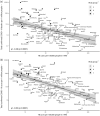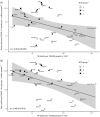Association of the past epidemic of Mycobacterium tuberculosis with mortality and incidence of COVID-19
- PMID: 34143810
- PMCID: PMC8213125
- DOI: 10.1371/journal.pone.0253169
Association of the past epidemic of Mycobacterium tuberculosis with mortality and incidence of COVID-19
Abstract
The coronavirus disease 2019 (COVID-19) pandemic, caused by the severe acute respiratory syndrome coronavirus 2 (SARS-CoV-2), has created a remarkable and varying impact in every country, inciting calls for broad attention. Recently, the Bacillus Calmette-Guérin (BCG) vaccination has been regarded as a potential candidate to explain this difference. Herein, we hypothesised that the past epidemic of Mycobacterium tuberculosis (M. tuberculosis) may act as a latent explanatory factor for the worldwide differences seen in COVID-19 impact on mortality and incidence. We compared two indicators of past epidemic of M. tuberculosis, specifically, incidence (90 countries in 1990) and mortality (28 countries in 1950), with the mortality and incidence of COVID-19. We determined that an inverse relationship existed between the past epidemic indicators of M. tuberculosis and current COVID-19 impact. The rate ratio of the cumulative COVID-19 mortality per 1 million was 2.70 (95% confidence interval [CI]: 1.09-6.68) per 1 unit decrease in the incidence rate of tuberculosis (per 100,000 people). The rate ratio of the cumulative COVID-19 incidence per 1 million was 2.07 (95% CI: 1.30-3.30). This association existed even after adjusting for potential confounders (rate of people aged 65 over, diabetes prevalence, the mortality rate from cardiovascular disease, and gross domestic product per capita), leading to an adjusted rate ratio of COVID-19 mortality of 2.44, (95% CI: 1.32-4.52) and a COVID-19 incidence of 1.31 (95% CI: 0.97-1.78). After latent infection, Mycobacterium survives in the human body and may continue to stimulate trained immunity. This study suggests a possible mechanism underlying the region-based variation in the COVID-19 impact.
Conflict of interest statement
The authors have declared that no competing interests exist.
Figures




Similar articles
-
Relationship between Bacillus Calmette Guerin Vaccination Policy and Coronavirus Disease-2019 (COVID-19) Incidence.Iran J Allergy Asthma Immunol. 2021 Feb 11;20(1):106-113. doi: 10.18502/ijaai.v20i1.5417. Iran J Allergy Asthma Immunol. 2021. PMID: 33639625
-
Stop playing with data: there is no sound evidence that Bacille Calmette-Guérin may avoid SARS-CoV-2 infection (for now).Acta Biomed. 2020 May 11;91(2):207-213. doi: 10.23750/abm.v91i2.9700. Acta Biomed. 2020. PMID: 32420947 Free PMC article. Review.
-
Potential role of Bacillus Calmette-Guérin (BCG) vaccination in COVID-19 pandemic mortality: Epidemiological and Immunological aspects.Asian Pac J Allergy Immunol. 2020 Sep;38(3):150-161. doi: 10.12932/AP-310520-0863. Asian Pac J Allergy Immunol. 2020. PMID: 32686943 Review.
-
The influence of vaccination against tuberculosis with the Bacillus-Calmette-Guérin(BCG) vaccine on COVID-19 incidence and mortality - review of the literature.Przegl Epidemiol. 2020;74(2):290-302. doi: 10.32394/pe.74.22. Przegl Epidemiol. 2020. PMID: 33115218 Review.
-
Role of latent tuberculosis infections in reduced COVID-19 mortality: Evidence from an instrumental variable method analysis.Med Hypotheses. 2020 Nov;144:110214. doi: 10.1016/j.mehy.2020.110214. Epub 2020 Aug 26. Med Hypotheses. 2020. PMID: 33254521 Free PMC article.
Cited by
-
BCG Vaccination: A potential tool against COVID-19 and COVID-19-like Black Swan incidents.Int Immunopharmacol. 2022 Jul;108:108870. doi: 10.1016/j.intimp.2022.108870. Epub 2022 May 17. Int Immunopharmacol. 2022. PMID: 35597119 Free PMC article. Review.
-
First and second doses of Covishield vaccine provided high level of protection against SARS-CoV-2 infection in highly transmissible settings: results from a prospective cohort of participants residing in congregate facilities in India.BMJ Glob Health. 2022 May;7(5):e008271. doi: 10.1136/bmjgh-2021-008271. BMJ Glob Health. 2022. PMID: 35609920 Free PMC article.
-
The Natural Effect of BCG Vaccination on COVID-19: The Debate Continues.Front Immunol. 2022 Jul 8;13:953228. doi: 10.3389/fimmu.2022.953228. eCollection 2022. Front Immunol. 2022. PMID: 35898508 Free PMC article. No abstract available.
-
Sex disparities of the effect of the COVID-19 pandemic on mortality among patients living with tuberculosis in the United States.Front Public Health. 2024 Jun 18;12:1413604. doi: 10.3389/fpubh.2024.1413604. eCollection 2024. Front Public Health. 2024. PMID: 38957204 Free PMC article.
-
A Descriptive Study on the Clinical Profile and Outcomes of Patients with COVID-19 and Tuberculosis Co-infection.Acta Med Philipp. 2024 May 15;58(8):42-49. doi: 10.47895/amp.vi0.7855. eCollection 2024. Acta Med Philipp. 2024. PMID: 38812770 Free PMC article.
References
-
- Ritchie H, Ortiz-Ospina E, Beltekian D, Mathieu E, Hasell J, Macdonald B, et al. Coronavirus Pandemic (COVID-19)–the data: Our World in Data; 2020 [updated August 7, 2020; cited 2020 August 7]. https://ourworldindata.org/coronavirus-data.
-
- de Vrieze J. Can a century-old TB vaccine steel the immune system against the new coronavirus?: Science; 2020 [updated Mar. 23, 2020; cited 2020 July 27]. https://www.sciencemag.org/news/2020/03/can-century-old-tb-vaccine-steel....
MeSH terms
Substances
LinkOut - more resources
Full Text Sources
Medical
Miscellaneous

